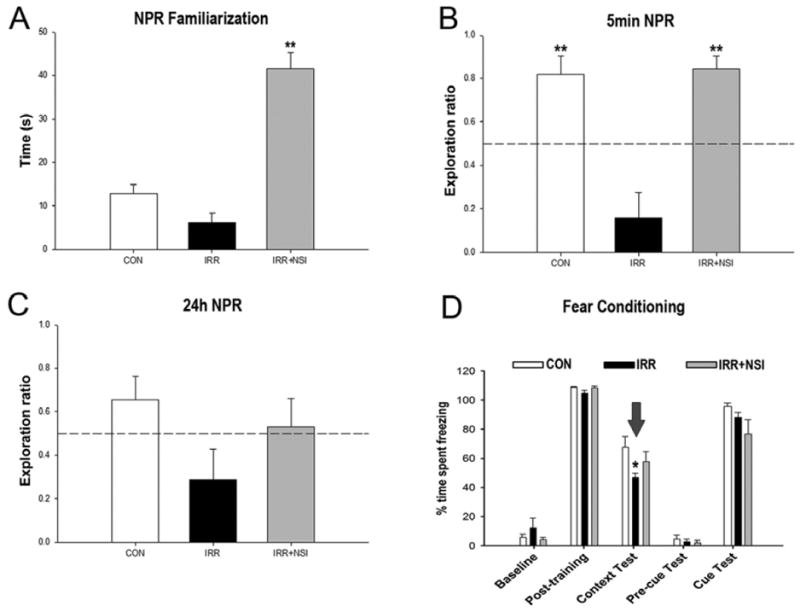Figure 2.

Human fetal-derived neural stem cell transplantation improved radiation-induced cognitive impairments at 1-month post-transplantation. For the novel place recognition task (NPR), animals were first familiarized with two identical objects in specific spatial locations in an open field arena, and total time spent exploring both identical objects was assessed. Following a 5-min retention interval, animal were placed in the same arena with one object moved to a novel spatial location. (A) Analysis of total time spent exploring both objects during the initial familiarization phase of NPR task revealed NSI-transplanted (IRR+NSI) animals explore more than controls- (CON) and irradiated-sham (IRR) groups (P’s<0.001, post hoc). Exploration ratios were calculated as, timenovel/timenovel+timefamiliar, for the first minute of 5min (B) and 24h (C) test sessions in NPR task. (B) In 5min test phase, IRR animals spent a significantly lower proportion of time exploring the novel place (P’s<0.001 vs. CON, and vs. IRR+NSI, post hoc), while CON and IRR+NSI animals did not differ. IRR animals did not spent more time exploring the novel place than expected by chance (dashed line at 50%). (C) 24h after the initial familiarization phase, animals were presented with the same two objects, with one moved to a new spatial location. None of the groups spent more time exploring the novel place than expected by chance. For the context and cued fear-conditioning task (D), baseline freezing levels were established using a series of 5 tone-shock pairings (post-training bars, D), and all groups showed increased post-training freezing behavior. 24h hour later, a context test was administered, and the IRR group spent significantly less time freezing compared to CON, while CON and IRR+NSI did not differ (P=0.014, post hoc comparisons, indicated by arrow). 48h after the initial training phase, the context was changed, which resulted in a substantial reduction in freezing behavior in all groups (pre-cue bars, D). Further, freezing levels were restored in all groups following the tone sound (cue test bars, D), indicating intact amygdala function in all groups Data are presented as Means + 1 SEM. P values were derived from FPLSD post hoc comparisons. *, P=0.014 indicates significant difference versus CON and IRR+NSI, and **, P=0.001 indicates significant difference versus IRR animals.
